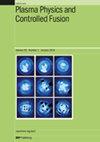Vertical instability forecasting and controllability assessment of multi-device tokamak plasmas in DECAF with data-driven optimization
IF 2.3
2区 物理与天体物理
Q2 PHYSICS, FLUIDS & PLASMAS
引用次数: 0
Abstract
Reliable vertical position control will be an essential element of any future tokamak-based fusion power plant in order to reduce disruptions and maximize performance. We investigate methods to improve vertical controllability boundary determination in plasma operational space and demonstrate a data-driven approach based on direct pseudoinversion of operational space data that is rigorously quantitative, applicable in real-time plasma control systems, and physically intuitive to interpret. Applied to historical shot data from entire run campaigns on the MAST-U, KSTAR, and NSTX tokamaks, this approach, implemented in DECAF, improves vertical displacement event identification accuracy to 98.9%–100%. Further, we explore the application of a physics-based vertical stability metric as an early warning forecaster for vertical displacement events. The development of a linear surrogate model for the plasma current density profile, with a coefficient of determination of 0.992 on the training dataset, enables potential employment of this forecaster in real-time. The application of this approach on historical data from the MAST-U MU02 campaign yields a forecaster with 62.6% accuracy, indicating promise for this method when further refined and potentially coupled with other stability metrics.利用数据驱动优化对 DECAF 中的多装置托卡马克等离子体进行垂直不稳定性预测和可控性评估
可靠的垂直位置控制将是未来任何基于托卡马克的聚变发电厂的基本要素,以减少中断并最大限度地提高性能。我们研究了改进等离子体运行空间垂直可控性边界确定的方法,并展示了一种基于运行空间数据直接伪反转的数据驱动方法,该方法定量严格,适用于实时等离子体控制系统,并能直观地进行物理解释。这种方法应用于 MAST-U、KSTAR 和 NSTX 托卡马克整个运行活动的历史拍摄数据,在 DECAF 中实施后,垂直位移事件识别准确率提高到 98.9%-100%。此外,我们还探索了基于物理学的垂直稳定性度量作为垂直位移事件预警预报器的应用。等离子体电流密度剖面线性代用模型的开发,在训练数据集上的决定系数为 0.992,使该预报器有可能实时投入使用。将这一方法应用于 MAST-U MU02 活动的历史数据,得出的预报准确率为 62.6%,表明这一方法在进一步完善并可能与其他稳定性指标相结合时大有可为。
本文章由计算机程序翻译,如有差异,请以英文原文为准。
求助全文
约1分钟内获得全文
求助全文
来源期刊

Plasma Physics and Controlled Fusion
物理-物理:核物理
CiteScore
4.50
自引率
13.60%
发文量
224
审稿时长
4.5 months
期刊介绍:
Plasma Physics and Controlled Fusion covers all aspects of the physics of hot, highly ionised plasmas. This includes results of current experimental and theoretical research on all aspects of the physics of high-temperature plasmas and of controlled nuclear fusion, including the basic phenomena in highly-ionised gases in the laboratory, in the ionosphere and in space, in magnetic-confinement and inertial-confinement fusion as well as related diagnostic methods.
Papers with a technological emphasis, for example in such topics as plasma control, fusion technology and diagnostics, are welcomed when the plasma physics is an integral part of the paper or when the technology is unique to plasma applications or new to the field of plasma physics. Papers on dusty plasma physics are welcome when there is a clear relevance to fusion.
 求助内容:
求助内容: 应助结果提醒方式:
应助结果提醒方式:


